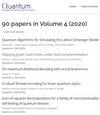Constant-depth circuits for Boolean functions and quantum memory devices using multi-qubit gates
IF 5.1
2区 物理与天体物理
Q1 PHYSICS, MULTIDISCIPLINARY
引用次数: 0
Abstract
We explore the power of the unbounded Fan-Out gate and the Global Tunable gates generated by Ising-type Hamiltonians in constructing constant-depth quantum circuits, with particular attention to quantum memory devices. We propose two types of constant-depth constructions for implementing Uniformly Controlled Gates. These gates include the Fan-In gates defined by $|x\rangle|b\rangle\mapsto |x\rangle|b\oplus f(x)\rangle$ for $x\in\{0,1\}^n$ and $b\in\{0,1\}$, where $f$ is a Boolean function. The first of our constructions is based on computing the one-hot encoding of the control register $|x\rangle$, while the second is based on Boolean analysis and exploits different representations of $f$ such as its Fourier expansion. Via these constructions, we obtain constant-depth circuits for the quantum counterparts of read-only and read-write memory devices – Quantum Random Access Memory (QRAM) and Quantum Random Access Gate (QRAG) – of memory size $n$. The implementation based on one-hot encoding requires either $O(n\log^{(d)}{n}\log^{(d+1)}{n})$ ancillae and $O(n\log^{(d)}{n})$ Fan-Out gates or $O(n\log^{(d)}{n})$ ancillae and $16d-10$ Global Tunable gates, where $d$ is any positive integer and $\log^{(d)}{n} = \log\cdots \log{n}$ is the $d$-times iterated logarithm. On the other hand, the implementation based on Boolean analysis requires $8d-6$ Global Tunable gates at the expense of $O(n^{1/(1-2^{-d})})$ ancillae.使用多量子比特门的布尔函数恒深电路和量子存储器件
我们探索了无界扇出门和由 Ising 型哈密顿产生的全局可调门在构建恒定深度量子电路中的威力,尤其关注量子存储器件。我们提出了两类实现均匀受控门的恒定深度结构。这些门包括由$|x\rangle|b\rangle\mapsto |x\rangle|b\oplus f(x)\rangle$定义的扇进门,其中$x\in\{0,1\}^n$和$b\in\{0,1\}$为布尔函数。我们的第一个构造是基于计算控制寄存器 $|x\rangle$ 的单次编码,而第二个构造则是基于布尔分析,并利用了 $f$ 的不同表示形式,如其傅里叶展开。通过这些构造,我们获得了内存大小为 $n$ 的只读和读写存储器设备--量子随机存取存储器(QRAM)和量子随机存取门(QRAG)--的量子对应恒定深度电路。基于单次热编码的实现需要 $O(n\log^{(d)}{n}\log^{(d+1)}{n})$ 放大门和 $O(n\log^{(d)}{n})$ 扇出门,或者 $O(n\log^{(d)}{n})$ 放大门和 $16d-10$ 全局可调门、其中,$d$ 是任意正整数,$\log^{(d)}{n} = \log\cdots \log{n}$ 是 $d$ 次迭代对数。另一方面,基于布尔分析的实现方法需要 8d-6$ 全局可调门,代价是需要 $O(n^{1/(1-2^{-d})})$ 分支。
本文章由计算机程序翻译,如有差异,请以英文原文为准。
求助全文
约1分钟内获得全文
求助全文
来源期刊

Quantum
Physics and Astronomy-Physics and Astronomy (miscellaneous)
CiteScore
9.20
自引率
10.90%
发文量
241
审稿时长
16 weeks
期刊介绍:
Quantum is an open-access peer-reviewed journal for quantum science and related fields. Quantum is non-profit and community-run: an effort by researchers and for researchers to make science more open and publishing more transparent and efficient.
 求助内容:
求助内容: 应助结果提醒方式:
应助结果提醒方式:


